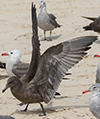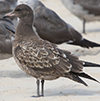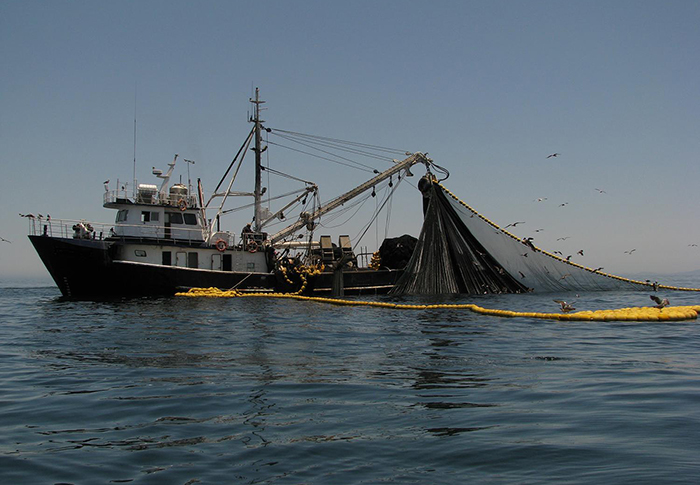|
||
Coordinators: 1cy June 2cy Jan 3cy Jan adult Jan |
1st cycle (1CY): JulyJuvenile birds, aged by the white fringed wing-coverts. Few birds show post-juvenile moult commencement in fresh dark grey feathers. Moult normally include (a variable number of) wing-coverts. Why are seabirds abandoning their ancestral nesting grounds in the Gulf of California?June 26, 2015, University of California - RiversideIsla Rasa, in the Gulf of California, is renowned for its massive aggregations of nesting seabirds. Over 95 percent of the world populations of Elegant Terns and Heerman's Gulls concentrate unfailingly every year on this tiny island to nest. Ever since the phenomenon was described by L. W. Walker in 1953 the island has been a magnet for tourists, naturalists, filmmakers, and seabird researchers. During some years in the last two decades, however, the seabirds have arrived to the island in April, as they usually do, but leave soon after without nesting. The first event was the 1998 "El Niño", when oceanic productivity collapsed all along the eastern Pacific coast from Chile to California. But then colony desertion happened again in 2003, and since then it has recurred with increasing frequency in 2009, 2010, 2014, and 2015. Researchers and conservationists were asking themselves where are the birds going when they leave their ancestral nesting ground, and what is causing the abandonment of their historic nesting site. A group of researchers from Mexico and the U.S. set out to analyze what was happening to the nesting Elegant Terns (Thalasseus elegans), a model species to monitor ocean dynamics. Their results, published in the AAAS journal Science Advances show that ocean warming and overfishing are producing the ecological collapse of the Gulf of California's productive Midriff region. Using nest counts in seabird colonies from Mexico and California, they found that Elegant Terns have expanded from the Gulf of California, in Mexico, into Southern California during the last two decades, but that the expansion fluctuates from year to year. "Whenever the terns perceive the conditions in the Gulf as inadequate to ensure successful reproduction," says Enriqueta Velarde, project leader, "they move to alternative nesting grounds in Southern California including the San Diego Saltworks, Bolsa Chica Ecological Reserve, and Los Angeles Harbor." The decision to remain in the Gulf or move to Southern California is related to the fact that during the last 15 years the Gulf of California has been getting abnormally warm during some seasons, and those peaks in sea surface temperatures have not been equally high along the California Current and Southern California Bight in the Pacific coast. "When the Gulf waters get unusually warm," explains Exequiel Ezcurra, a longtime collaborator of Velarde and a professor of ecology at the University of California, Riverside, "the sea becomes capped by a layer of warm surface water and the upwelling of cold, nutrient-rich waters fails to reach the surface. Productivity declines and, with it, the availability of small pelagic fish, on which the seabirds feed, also falls." The collapse in food for the seabirds that results from warming waters, the study shows, is compounded by the reduction in sardine populations brought by intensive fishing in Mexico. Confronted with lack of food, the seabirds take off towards the coasts of Southern California. Sardine fishing boat in the Gulf of California´s Midriff Island Region, hauling the purse-seine net after a fishing operation in 2013, when their catch of Pacific sardine had nearly collapsed. Credit: E. Velarde. Increased frequencies of abnormally warm waters in the Gulf of California, possibly as a result of globally warming oceans, coupled with extremely high fishing pressure, are delivering a combined blow to the legendary productivity of the Gulf of California, forcing seabirds to fly away in search for more suitable environments, even if that means abandoning their ancestral nesting grounds and moving into highly transformed industrial landscapes such as the San Diego Saltworks or the LA Harbor Container Terminal. More information: Enriqueta Velarde, Exequiel Ezcurra, Michael H. Horn, & Robert T. Patton; Warm oceanographic anomalies and fishing pressure drive seabird nesting north. Science Advances, 26 June 2015. advances.sciencemag.org/content/1/5/e1400210 |
 Heermann's Gull heermannii 1st cycle (1CY), July 23 2018, Pismo Beach, California USA. Picture: Alex Abela. Heermann's Gull heermannii 1st cycle (1CY), July 23 2018, Pismo Beach, California USA. Picture: Alex Abela. |
 Heermann's Gull heermannii 1st cycle (1CY), July 12 2018, Guadaloupe, California USA. Picture: Alex Abela. Heermann's Gull heermannii 1st cycle (1CY), July 12 2018, Guadaloupe, California USA. Picture: Alex Abela. |
||
 Heermann's Gull heermannii 1st cycle (1CY), July 23 2018, Pismo Beach, California USA. Picture: Alex Abela. Heermann's Gull heermannii 1st cycle (1CY), July 23 2018, Pismo Beach, California USA. Picture: Alex Abela. |
||
 Heermann's Gull heermannii 1st cycle (1CY), July 23 2018, Pismo Beach, California USA. Picture: Alex Abela. Heermann's Gull heermannii 1st cycle (1CY), July 23 2018, Pismo Beach, California USA. Picture: Alex Abela. |
||
 Heermann's Gull heermannii 1st cycle (1CY), July 28 2018, Pismo Beach, California USA. Picture: Alex Abela. Heermann's Gull heermannii 1st cycle (1CY), July 28 2018, Pismo Beach, California USA. Picture: Alex Abela. |
||
 Heermann's Gull heermannii 1st cycle (1CY), July 23 2018, Pismo Beach, California USA. Picture: Alex Abela. Heermann's Gull heermannii 1st cycle (1CY), July 23 2018, Pismo Beach, California USA. Picture: Alex Abela. |
||
 Heermann's Gull heermannii 1st cycle (1CY), July 23 2018, Pismo Beach, California USA. Picture: Alex Abela. Heermann's Gull heermannii 1st cycle (1CY), July 23 2018, Pismo Beach, California USA. Picture: Alex Abela. |
||
 Heermann's Gull heermannii 1st cycle (1CY), July 09 2017, Pismo Beach, California USA. Picture: Alex Abela. Heermann's Gull heermannii 1st cycle (1CY), July 09 2017, Pismo Beach, California USA. Picture: Alex Abela. |
||
 Heermann's Gull heermannii 1st cycle (1CY), July 29 2017, Pismo Beach, California USA. Picture: Alex Abela. Heermann's Gull heermannii 1st cycle (1CY), July 29 2017, Pismo Beach, California USA. Picture: Alex Abela. |
||
 Heermann's Gull heermannii 1st cycle (1CY), July 24 2017, Pismo Beach, California USA. Picture: Alex Abela. Heermann's Gull heermannii 1st cycle (1CY), July 24 2017, Pismo Beach, California USA. Picture: Alex Abela. |
||
 Heermann's Gull heermannii 1st cycle (1CY), July 30 2017, Pismo Beach, California USA. Picture: Alex Abela. Heermann's Gull heermannii 1st cycle (1CY), July 30 2017, Pismo Beach, California USA. Picture: Alex Abela. |
||
 Heermann's Gull heermannii 1st cycle (1CY), July 30 2017, Pismo Beach, California USA. Picture: Alex Abela. Heermann's Gull heermannii 1st cycle (1CY), July 30 2017, Pismo Beach, California USA. Picture: Alex Abela. |
||
 Heermann's Gull heermannii 1st cycle (1CY), July 30 2017, Pismo Beach, California USA. Picture: Alex Abela. Heermann's Gull heermannii 1st cycle (1CY), July 30 2017, Pismo Beach, California USA. Picture: Alex Abela. |
||
 Heermann's Gull heermannii 1st cycle (1CY), July 30 2017, Pismo Beach, California USA. Picture: Alex Abela. Heermann's Gull heermannii 1st cycle (1CY), July 30 2017, Pismo Beach, California USA. Picture: Alex Abela. |
||
 Heermann's Gull heermannii 1st cycle (1CY), July 24 2017, Pismo Beach, California USA. Picture: Alex Abela. Heermann's Gull heermannii 1st cycle (1CY), July 24 2017, Pismo Beach, California USA. Picture: Alex Abela. |
||
 Heermann's Gull heermannii 1st cycle (1CY), July 24 2017, Pismo Beach, California USA. Picture: Alex Abela. Heermann's Gull heermannii 1st cycle (1CY), July 24 2017, Pismo Beach, California USA. Picture: Alex Abela. |
||
 Heermann's Gull heermannii 1st cycle (1CY), July 30 2017, Pismo Beach, California USA. Picture: Alex Abela. Heermann's Gull heermannii 1st cycle (1CY), July 30 2017, Pismo Beach, California USA. Picture: Alex Abela. |
||
 Heermann's Gull heermannii 1st cycle (1CY), July 24 2017, Pismo Beach, California USA. Picture: Alex Abela. Heermann's Gull heermannii 1st cycle (1CY), July 24 2017, Pismo Beach, California USA. Picture: Alex Abela. |
||
 Heermann's Gull heermannii 1st cycle (1CY), July 09 2017, Pismo Beach, California USA. Picture: Alex Abela. Heermann's Gull heermannii 1st cycle (1CY), July 09 2017, Pismo Beach, California USA. Picture: Alex Abela. |
||
 Heermann's Gull heermannii 1st cycle (1CY), July 09 2017, Half Moon Bay, California USA. Picture: Malia Kai De Felice. Heermann's Gull heermannii 1st cycle (1CY), July 09 2017, Half Moon Bay, California USA. Picture: Malia Kai De Felice. |
||
 Heermann's Gull heermannii 1st cycle (1CY), July 20 2017, Monterey, California USA. Picture: Blake Matheson. Heermann's Gull heermannii 1st cycle (1CY), July 20 2017, Monterey, California USA. Picture: Blake Matheson. |
||
 Heermann's Gull heermannii 1st cycle (1CY), July 14 2017, Half Moon Bay, California USA. Picture: Alvaro Jaramillo. Heermann's Gull heermannii 1st cycle (1CY), July 14 2017, Half Moon Bay, California USA. Picture: Alvaro Jaramillo. |
||
 Heermann's Gull heermannii 1st cycle (1CY), July 17 2016, Half Moon Bay, California USA. Picture: Malia Kai De Felice. Heermann's Gull heermannii 1st cycle (1CY), July 17 2016, Half Moon Bay, California USA. Picture: Malia Kai De Felice. |
||
 Heermann's Gull heermannii 1st cycle (1CY), July 29 2017, Half Moon Bay, California USA. Picture: Malia Kai De Felice. Heermann's Gull heermannii 1st cycle (1CY), July 29 2017, Half Moon Bay, California USA. Picture: Malia Kai De Felice. |
||
 Heermann's Gull heermannii 1st cycle (1CY), July 30 2017, Pismo Beach, California USA. Picture: Alex Abela. Heermann's Gull heermannii 1st cycle (1CY), July 30 2017, Pismo Beach, California USA. Picture: Alex Abela. |
||
 Heermann's Gull heermannii 1st cycle (1CY), July 30 2017, Pismo Beach, California USA. Picture: Alex Abela. Heermann's Gull heermannii 1st cycle (1CY), July 30 2017, Pismo Beach, California USA. Picture: Alex Abela. |
||
 Heermann's Gull heermannii
Heermann's Gull heermannii